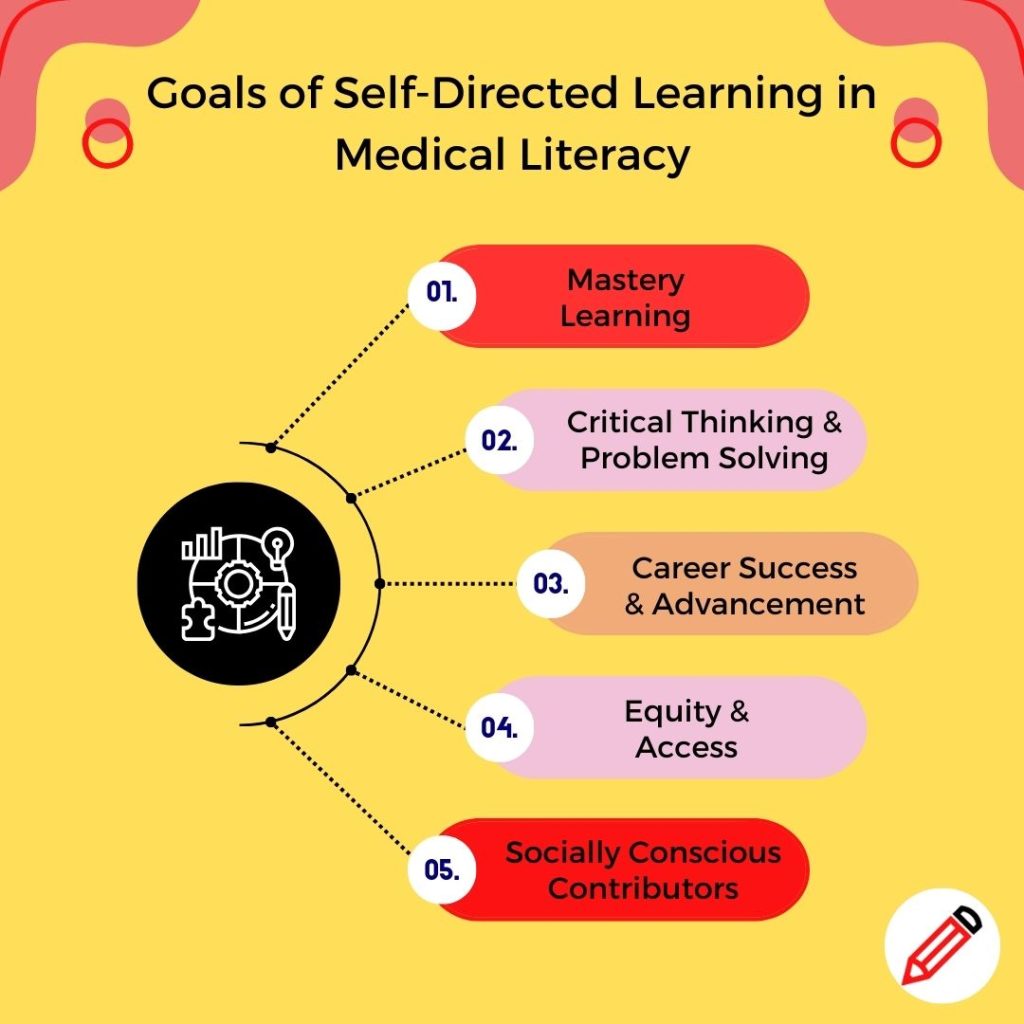In the dynamic landscape of STEM education, the integration of self-directed learning principles is pivotal, particularly in teaching medical literacy. Empowering students to take ownership of their learning journey not only fosters mastery of medical concepts but also cultivates crucial skills in problem-solving, fuels career success, and ensures equitable access to medical literacy. Furthermore, it’s imperative that medical literacy education produces socially responsible and empathetic contributors capable of navigating complex healthcare challenges.

Mastery Through Self-Directed Learning
Self-directed learning empowers students to delve deeper into medical literacy at their own pace, facilitating a deeper understanding of complex medical concepts. This approach allows for mastery learning, ensuring that students grasp foundational principles before progressing to more advanced topics. Mastery in medical literacy equips students with a solid foundation, enabling them to navigate the intricate intersections of STEM and healthcare.
Problem Solving & Critical Thinking
A cornerstone of self-directed learning lies in nurturing problem-solving skills and critical thinking abilities. Teaching medical literacy through this approach encourages students to tackle real-world healthcare issues, analyze medical data, and devise innovative solutions. By promoting inquiry and exploration, self-directed learning instills a mindset where students approach medical challenges with curiosity and analytical reasoning, fostering adaptive problem-solving skills crucial in healthcare innovation.
Career Success and Advancement
Equipping students with self-directed learning skills in medical literacy lays the groundwork for successful STEM careers. Individuals adept at directing their own learning journey possess the resilience, adaptability, and self-motivation necessary for success in dynamic fields like biotechnology, healthcare technology, research, and medicine. They navigate complex scientific advancements and emerge as innovative contributors driving progress in the healthcare landscape.
Equity and Access to Medical Literacy
An equitable approach to education is imperative in ensuring that all students, regardless of background or circumstances, have access to medical literacy. Self-directed learning, with its flexibility and individualized approach, addresses diverse learning needs and styles. It allows for tailoring educational experiences to meet the unique requirements of each student, bridging gaps and promoting inclusion in accessing medical knowledge and skills.
Produce Socially Conscious Contributors
An approach to medical literacy education that lacks equity and social consciousness falls short in preparing students to address real-world healthcare challenges. Self-directed learning, when coupled with a spirit of social responsibility, healthcare equity, compassion, and empathy, nurtures future healthcare contributors who understand the societal reasons and implications of their work. Self-directed learning supports the beliefs and attitudes that no one should be left behind, which provides the broad support needed to drive sustainable innovation and progress.
Strategies for Implementing Self-Directed Medical Literacy
To effectively employ self-directed learning in teaching medical literacy:
- Resource Adaptability: Provide diverse resources, including interactive modules, research projects, and case studies, catering to different learning preferences. Each learning resource may be an option in a multi-modal education program.
- Choice and Flexibility: Offer students autonomy in selecting medical topics aligned with their interests, allowing for personalized learning pathways.
- Reflection and Feedback: Incorporate reflection activities and feedback mechanisms to foster metacognitive skills, encouraging students to monitor their learning progress.
- Community Engagement: Facilitate discussions, community-based projects, or interactions with healthcare professionals to emphasize the social impact of medical literacy.
Empower Future STEM Innovators with Self-Directed Learning in Medical Literacy
Incorporating self-directed learning principles into the teaching of medical literacy within STEM programs empowers students to become proficient, adaptable, empathetic and socially conscious healthcare contributors. Mastery of medical concepts, honed problem-solving skills, and equitable access to knowledge converge to shape a generation of STEM professionals capable of addressing healthcare challenges.
===
Interested in teaching medical literacy pain free? Shop medical literacy resources!

This article was drafted by ChatGPT and edited by Joan Lee Tu, the founder of MedULingo.com.
You may also be interested in the following articles:
Fostering Medical Literacy with Self-Directed Learning in Home Education
How Medical Literacy Activity Books Empower Learners in STEM Education
How to Promote Self-Directed Learning in Medical Education
Why Medical Literacy Needs To Be In Your School STEM Program
Why a Robust STEM Education Program Needs to Include Medical Literacy
20 Benefits of Including Medical Literacy in Your STEM Program
How Medical Literacy Activity Books Empower Learners in STEM Education
How to Empower Future STEM Innovators with Self-Directed Learning in Medical Literacy
Why STEM Education Needs Medical Literacy to Foster Healthcare Innovators
Why You Need Diverse Learning Modalities for Medical Literacy
Building Foundational Medical Literacy Skills in STEM Education
Four Cs of Medical Literacy: Comprehension, Conversation, Communication, Collaboration

